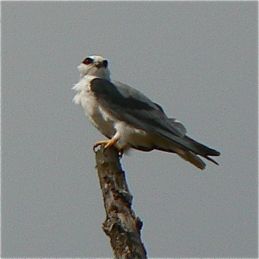“On January 11th, 2009, while observing birds on Pulau Semakau, I noticed a harrier in the distance. It was hunting low over the grassland. Soon, I was able to obtain a much closer view and the plumage was distinctive; a male *Western Marsh Harrier (Circus aeruginosus) (left top). This is quite a rare migrant to Singapore. This autumn, there had been at least one other bird at Changi between October – December.
“Suddenly, a Black-winged Kite (Elanus caeruleus) came out of nowhere and started mobbing the harrier (left bottom). The harrier dived for cover, into the tall grass. After a few seconds, the kite flew into a clump of trees.
“The Black-winged Kite is our only resident raptor that specialises on hunting over grasslands. They do so by hovering over a particular area for a few seconds, before flying a short distance to repeat the hovering watch again. If a prey item is spotted, the kite will swoop in for the kill. They prey on small rodents, reptiles and birds.
“During the northern winter period, certain migratory raptors turn up that are also grassland specialists. These include the harriers and kestrels. Hence, during this time of the year, the resident kites face competition, for food, within their territories.
“As none of the Black-winged Kite’s grassland habitats are protected in Singapore, this resident bird-of-prey has to cope, each year, with the loss of temporary homes. As long as reclamation continues, the kite will find new temporary homes at places like Changi, Tuas and even Pulau Semakau. This cannot and should not continue though, as reclamation also means the loss of marine habitats, especially our inter-tidal areas. How do we ensure that the Black-winged Kite and many other grassland bird species, both resident and migrant, continue to survive in Singapore? How do we provide man-made environments, like grasslands, without it being at the expense of habitats of greater biodiversity?”
Subaraj Rajathurai
13th January 2009
*Please see HERE.











5 Responses
May I know why this is a WMH and not EMH?
Thanks for the enquiry Kok Hui. Perhaps my photo is too small and does not show all the features well. Robson shows the differences between EM and WM well.
The pale underwing with dark tips indicate a male and in WM, the tips are prominent and black; The WM male has a paler head that can also be seen here; the male EM has pale whitish underparts while the male WM has rufous to chestnut underparts that are clearly visible in the photo; additionally, the male WM shows more brown on neck which is also visble here.
There are other features visible in the field but not from this photo. Hope that helps.
Hi Subaraj, thanks for the pointers. Will keep a look out for it.
This looks like an Eastern Marsh Harrier to me.
My evaluation is as follows:
Upperwing: the dark subterminal spots of the grey secondaries are clearly visible, forming a dark subterminal trailing edge – a feature of male EMH absent in male WMH which has plain grey secondaries.
Underparts: primaries are light coloured with dark bands and tips – a male WMH would have all dark primaries while a male EMH would have brown primaries with dark bands. The photo shows paler primaries with dark bands and the dark bands are indicative of EMH.
Not particularly clear in the photo but the inner wing appears to be pale with light brown barring – underwing barring (especially of the secondaries) is a feature of female EMH. It is useful to state again that during the transition from juvenile to adult male plumage, the bird may exhibit some features resembling female harriers.
Together, the underwing primaries and the inner underwing (plus the upperwing) indicates a subadult male. The subadult status would explain the “rufous to chestnut underparts”.
Head pattern: Again, not very clear in the photo but the head looks very pale, with the pale colour completely surrounding the darker eye. An adult male WMH would have a pale head with brown streaks while a juvenile WMH would have dark colour immediately behind the eye (like an eye stripe). The pale colour completely surrounding the eye (as shown in the photo) is typical for juvenile EMH.
Based on the above analysis, I am of the opinion that this sighting is of a subadult male Eastern Marsh Harrier also.